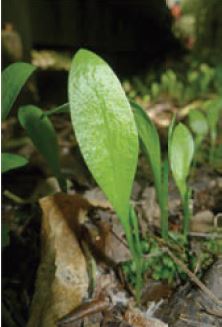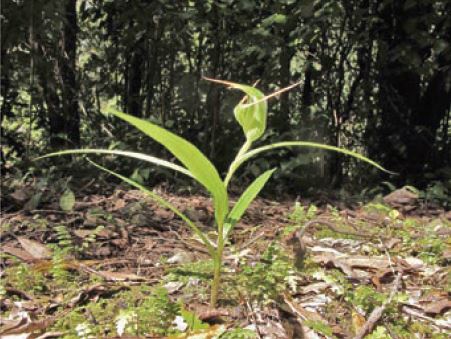Trip Report – 5 November 2016 : Rimutaka Forest Park Nga Taonga Nature Walk
 |
Ophioglossum coriaceum. Photo: Leon Perrie |
Nga Taonga Nature Walk, in Rimutaka Forest Park’s south-west, is a gentle 45-minute walk, on a wellformed track, near Catchpool Stream, a tributary of the Wainuiomata River. It is surprisingly rich in botanical interest, so our progress was slow; at one point we noticed that the signs told us our cars were 15 minutes away from the end, and yet we had been on the track for exactly 3 hours! We left from the car-park, walking through planted and picnic areas. There are bridges, a well-built board-walk, and informative and sturdy interpretation panels. There is one small rise, and a couple of slightly rough patches to negotiate. We ended at the road, and strolled back to the car park.
One of the first interesting finds was by Lara, who discovered a patch of Ophioglossum coriaceum / adder’s tongue. While not a rare fern, it is not often seen. In New Zealand ferns and allied plants (Brownsey and SmithDodsworth), it is described as: ‘Much more common than is generally supposed ... often hard to spot, dying down completely in winter’. Th ose we saw were not fully developed, as the fertile spikes were not much taller than the sterile laminae.
Chris Hopkins showed us Melicytus micranthus / swamp mahoe, another of the small-leaved divaricating plants. It is known by some for the pale blotch at the base of the leaf, and its obvious network of veins on the upper surface of the wobbly-edged leaf (‘margins gently and roundly toothed or scalloped’ - Hugh Wilson). It can look like a juvenile kaikomako / Pennantia corymbosa.
The Pterostylis banksii were spectacular, along the edges of the track, and up on the banks. They were so healthy and large, that someone made the comment that they were on steroids!
 |
Pterostylis banksii. Photo: Sunita Singh |
A patch of tall tawa forest plunged us into darkness, before we came out again, and went down to a sunny spot on the stream bank for lunch. Leon was fascinated by the tiny fish he spotted, wondering if they were inanga, but saying that there weren’t enough for even a small whitebait fritter.
We saw some very large old trees along the way, a large northern rata, and a rimu of d.b.h. c. 1m. It is surprisingly easy to miss these large trees when you have been concentrating close up on much tinier and more detailed botany.
Several members commented on what a surprisingly good track it was for botanical interest, and that they hadn’t known of its presence before. We added about thirty-five plants to the species list. Compilation of this list began on the Orongorongo Track (1.8.2009), then on the Old Five-Mile Track (2.7.2016), so the result is a more comprehensive list for the Catchpool Valley.
For photographs taken on this trip, go to: http://naturewatch.org.nz/observations?on=2016-11-05&place_id=6803&q=wellingtonbotanicalsociety&subview=table
Participants : Peter Beveridge, Helen Bichan, Peter Cooper, Kat de Silva, Gavin Dench, Ian & Jill Goodwin (co-leaders, co-scribes), Bryan Halliday, Chris Hopkins, Chris Horne, Rodney Lewington, Barbara Mitcalfe, Tony Payne, Leon Perrie, Lara Shepherd, Darea Sherratt, Karin Sievwright, Sunita Singh, John Van den Hoeven, Julia White.

 Site Index
Site Index







 Site Index
Site Index





